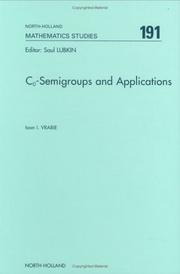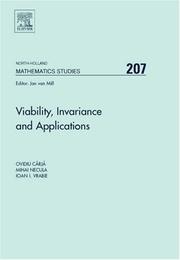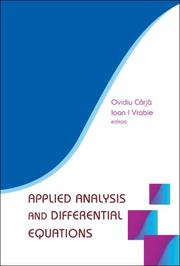| Listing 1 - 6 of 6 |
Sort by
|
Book
ISBN: 0582003199 0470207388 9780582003194 Year: 1987 Publisher: New York (N.Y.) : Longman,
Abstract | Keywords | Export | Availability | Bookmark
 Loading...
Loading...Choose an application
- Reference Manager
- EndNote
- RefWorks (Direct export to RefWorks)

ISBN: 9780444512888 0444512888 9780080530048 0080530044 1281033987 9781281033987 9786611033989 661103398X Year: 2003 Publisher: Amsterdam Boston Elsevier Science
Abstract | Keywords | Export | Availability | Bookmark
 Loading...
Loading...Choose an application
- Reference Manager
- EndNote
- RefWorks (Direct export to RefWorks)
The book contains a unitary and systematic presentation of both classical and very recent parts of a fundamental branch of functional analysis: linear semigroup theory with main emphasis on examples and applications. There are several specialized, but quite interesting, topics which didn't find their place into a monograph till now, mainly because they are very new. So, the book, although containing the main parts of the classical theory of Co-semigroups, as the Hille-Yosida theory, includes also several very new results, as for instance those referring to various classes of semigr
Semigroups of operators. --- Operators, Semigroups of --- Operator theory

ISBN: 9780444512888 0444512888 9780080530048 0080530044 1281033987 9781281033987 9786611033989 661103398X Year: 2003 Publisher: Boston Elsevier Science
Abstract | Keywords | Export | Availability | Bookmark
 Loading...
Loading...Choose an application
- Reference Manager
- EndNote
- RefWorks (Direct export to RefWorks)
The book contains a unitary and systematic presentation of both classical and very recent parts of a fundamental branch of functional analysis: linear semigroup theory with main emphasis on examples and applications. There are several specialized, but quite interesting, topics which didn't find their place into a monograph till now, mainly because they are very new. So, the book, although containing the main parts of the classical theory of Co-semigroups, as the Hille-Yosida theory, includes also several very new results, as for instance those referring to various classes of semigr

ISBN: 1281021555 9786611021559 0080521665 0444527613 9780444527615 9780080521664 9781281021557 Year: 2007 Volume: 207 Publisher: Amsterdam ; Boston : Elsevier,
Abstract | Keywords | Export | Availability | Bookmark
 Loading...
Loading...Choose an application
- Reference Manager
- EndNote
- RefWorks (Direct export to RefWorks)
The book is an almost self-contained presentation of the most important concepts and results in viability and invariance. The viability of a set K with respect to a given function (or multi-function) F, defined on it, describes the property that, for each initial data in K, the differential equation (or inclusion) driven by that function or multi-function) to have at least one solution. The invariance of a set K with respect to a function (or multi-function) F, defined on a larger set D, is that property which says that each solution of the differential equation (or inclusion) driven by F and
Differential equations. --- Mathematics. --- Set theory. --- Symmetry (Mathematics). --- Differential equations --- Set theory --- Symmetry (Mathematics) --- Calculus --- Mathematics --- Physical Sciences & Mathematics --- Invariance (Mathematics) --- Aggregates --- Classes (Mathematics) --- Ensembles (Mathematics) --- Mathematical sets --- Sets (Mathematics) --- Theory of sets --- 517.91 Differential equations --- Group theory --- Automorphisms --- Logic, Symbolic and mathematical

ISBN: 9780444527615 0444527613 9780080521664 0080521665 1281021555 9781281021557 Year: 2007 Publisher: Boston Elsevier
Abstract | Keywords | Export | Availability | Bookmark
 Loading...
Loading...Choose an application
- Reference Manager
- EndNote
- RefWorks (Direct export to RefWorks)
The book is an almost self-contained presentation of the most important concepts and results in viability and invariance. The viability of a set K with respect to a given function (or multi-function) F, defined on it, describes the property that, for each initial data in K, the differential equation (or inclusion) driven by that function or multi-function) to have at least one solution. The invariance of a set K with respect to a function (or multi-function) F, defined on a larger set D, is that property which says that each solution of the differential equation (or inclusion) driven by F and issuing in K remains in K, at least for a short time. The book includes the most important necessary and sufficient conditions for viability starting with Nagumos Viability Theorem for ordinary differential equations with continuous right-hand sides and continuing with the corresponding extensions either to differential inclusions or to semilinear or even fully nonlinear evolution equations, systems and inclusions. In the latter (i.e. multi-valued) cases, the results (based on two completely new tangency concepts), all due to the authors, are original and extend significantly, in several directions, their well-known classical counterparts. - New concepts for multi-functions as the classical tangent vectors for functions - Provides the very general and necessary conditions for viability in the case of differential inclusions, semilinear and fully nonlinear evolution inclusions - Clarifying examples, illustrations and numerous problems, completely and carefully solved - Illustrates the applications from theory into practice - Very clear and elegant style.

ISBN: 1281121630 9786611121631 9812708227 9789812708229 9789812705945 9812705945 9781281121639 Year: 2007 Publisher: Singapore ; Hackensack, N.J. : World Scientific,
Abstract | Keywords | Export | Availability | Bookmark
 Loading...
Loading...Choose an application
- Reference Manager
- EndNote
- RefWorks (Direct export to RefWorks)
This volume contains refereed research articles written by experts in the field of applied analysis, differential equations and related topics. Well-known leading mathematicians worldwide and prominent young scientists cover a diverse range of topics, including the most exciting recent developments. A broad range of topics of recent interest are treated: existence, uniqueness, viability, asymptotic stability, viscosity solutions, controllability and numerical analysis for ODE, PDE and stochastic equations. The scope of the book is wide, ranging from pure mathematics to various applied fields s
| Listing 1 - 6 of 6 |
Sort by
|

 Search
Search Feedback
Feedback About UniCat
About UniCat  Help
Help News
News